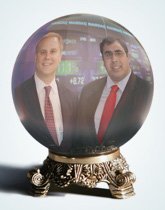
Philip Dowd no longer goes to the office every day, but he doesn't consider himself retired. In fact, in many ways, what he does now isn't that different from what he did throughout his professional career. For more than three decades, he spent his days on the hunt for new ideas—buying startup tech firms for SunGard, a software and information technology (IT) services company he and some others cofounded. He had quite a track record, too, helping to acquire 100 IT companies that enabled SunGard's revenues to grow from $30 million in 1984 to more than $1.5 billion when he stepped down in 2002.
Today, Dowd and his wife, Marsha, who consider themselves "venture capitalists," still hunt for new ideas through the Philip and Marsha Dowd Engineering Seed Fund they have established at Carnegie Mellon. Just like the SunGard accomplishments, there have been quite a few success stories since the fund was established in 2002: A total of 25 Carnegie Institute of Technology graduate students in the Institute for Complex Engineered Systems (ICES) have received the fellowship; and from their Dowd-sponsored work have come 15 patents, two spinoff companies, and millions in follow-up funding in the form of national grants from the U.S. National Institutes of Health, National Science Foundation, and the like.
Dowd, who earned his engineering degree from Carnegie Mellon in 1963, is nothing if not a savvy investor. "We're interested in finding those people and those ideas that are so cutting edge they're ahead of their time. And we're interested in giving them the boost they need to move forward in our time."
That "boost" is much sought after by students. "We'll get 20, 30 applicants every year. And they're all good, almost without exception," says Pradeep Khosla, dean of the engineering college and head of the Dowd Fellowship selection committee. Gary Fedder, ICES director and another member of the selection committee, adds, "It's a little like the boardroom scenes in 'The Apprentice.' You have all these graduate students standing in the hallway straightening their ties, practicing their speeches."
Sasha Bakhru knows that feeling. The biomedical engineering PhD student had enrolled in a class called Surgery for Engineers, in which a student is paired with a practicing surgeon. Bakhru was paired with Raymond Sekula, a neurosurgeon who happened to be pursuing his MBA at Tepper. The two began collaborating on the problem of neural stem cells.
Everyone has a certain amount of stem cells—which are, in essence, "blank" cells, not yet differentiated. If someone could figure out a way to get at and harness a person's own stem cells, the capacity to heal the body would be limitless. The only way, though, to harvest neural stem cells is to do a craniotomy—literally drilling a hole in a person's head—and extracting tissue. Sekula and Bakhru thought that there might be potential in a much less invasive procedure, extracting cerebrospinal fluid from the thecal sac, just below the spinal cord, where they hypothesized some of these cells may reside. But to explore such a groundbreaking procedure would require funding. "I would have to spend all my time at Carnegie Mellon on small studies, a paper here and there, nibbling around the edges of this big idea," Bakhru explains. "I'd try to use those small studies of mine to generate grants to generate more small studies, on and on. The cycle would take years."
Bakhru was experiencing an all-too-common post-graduate paradox for people who choose to stay in academia. Namely, you need funding to do research, but to get funding, you need to be able to show results—from research. So students and junior faculty are often forced to sign on to existing research groups rather than pursue tangential interests or new ideas. Under those conditions, how does a young upstart pursue "cutting-edge" research?

Enter the Dowd fellowship. In the case of Bakhru and his team, Marsha recalls, laughing, "It was a motley bunch. A biomedical PhD student, a junior faculty member specializing in Microsystems engineering, and a neurosurgeon who happened to be at Tepper. They even had a Communications department faculty member help them prepare a business plan based on their concept. What a classic Carnegie Mellon caper."
"But," Philip adds, "it became clear right off the bat that they just might change the world."
Bakhru and his team got the Dowd fellowship and began stem cell research. Since that time, they have proven that neurological stem cells can be extracted, expanded into therapeutic quantities, and stored indefinitely for later use if a person were to later develop a disorder like Parkinson's disease or multiple sclerosis. Their research has led to three patent applications on the processes. With the help of Tepper, they entered their business plan based on the concept into a national competition usually reserved for MBA students. They won. With that seed money, they launched a startup company called NeuroBank. Bakhru estimates that "within 15 years" it's entirely possible they'll have introduced a totally novel way of combating and treating a wide array of neurological disorders.
Philip Dowd smiles when he thinks of it. "How many other ideas are out there like this, ideas that have the capacity to change the world, if only they had a chance?"
This year, the work of the four Dowd fellows includes:
- using nanotechnology in tissue engineering;
- improving efficiency in LED semiconductors;
- optimizing bone drilling in orthopedic surgery;
- rethinking the way plug-in hybrids interact with the electric grid.
Bradley A. Porter (HS'08) is a freelance writer and regular contributor to this magazine.



